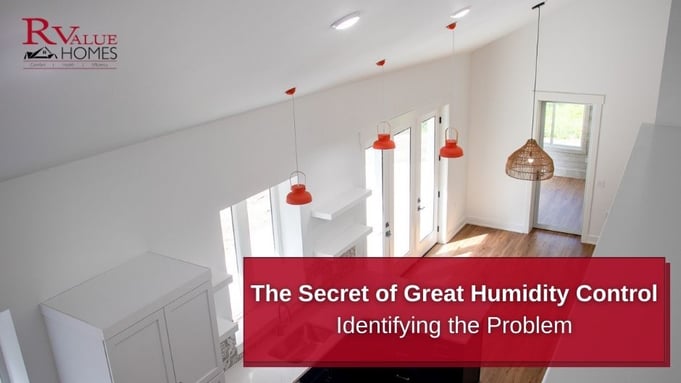4 Min Read
The Secret of Great Humidity Control Part 1: Identifying the Problem
Humidity control in West Michigan is a challenge. Unlike Phoenix or Atlanta, Grand Rapids weather cycles between humid and dry in a matter of days, no matter the season. Despite this, excellent humidity control is no secret. While we think every custom home builder and HVAC contractor should understand this, you may need to educate your team. Here’s some help:

What do I mean by "Humidity?"
By humidity, I simply mean water vapor. For our purposes, vapor and humidity are interchangeable terms. Water in it’s gaseous state.
Let's test your knowledge before we start: What does 100% humidity look like?
Nope, not rain. The answer is fog!
First, a couple terms:
Absolute humidity is not temperature dependent. Warmer air can hold more moisture than cooler air. Just like boiling water can dissolve a lot more sugar than cold water. In general then, cooler air is drier air (even though cold air can be humid).
Relative humidity is a measurement that compares the amount of humidity in the air with the amount the air could possibly hold at a given temperature.
Dewpoint. The temperature at which the air becomes saturated, or 100% relative humidity. Dewpoint is an important number, because in a home we need to avoid any surface temperatures at or below the dewpoint, if we wish to avoid things like condensation, mold, and rot.
When absolute humidity remains unchanged, the dewpoint is unchanged; however the relative humidity of air goes down as the temperature rises. This explains why many homes dry out in the winter—it isn’t the furnace, or the wood heat, or whatever your mother told you. The fact of the matter is that cold outdoor air makes its way into the home, where it becomes heated and the relative humidity is thus lowered. The amount of moisture in the air hasn’t changed, but it sure is dry air!
Why does Humidity matter?
Comfort
We all know what it means for our homes to be muggy or stuffy. Funny words, but not a fun experience! Even if you don’t have to wring out your shirt, dry air has it’s own set of concerns: itchy skin, static electricity, and dry mucous membranes (which make us more susceptible to infection, see below). The right humidity level provides greater comfort.
We all know how lower humidity in the summer is far more comfortable. But did you also know that low humidity feels cooler in the heating season too? During the winter months, low humidity is less comfortable.
Ideal humidity levels for comfort will vary somewhat person by person. But speaking generally, 45% to 55% relative humidity is comfortable year round.
Health
Most of us are completely unaware of the fact that there is a humidity level that is healthier! What do I mean?
This is the Sterling chart, and it wasn’t created by AprilAire. In fact it was created by researchers from a 1986 research paper.
I’m not going to add any interpretation to the chart, as it is pretty clear that 40% to 60% relative humidity is ideal for health.
The one thing it doesn’t take into account is durability. And that is a factor we must consider.
Durability
Durability is a very significant concern that easily trumps the comfort and even the health concerns. Durability is the reason many builders allow their homes to dry out in the winter. But it doesn’t have to be that way.
Despite being on opposite ends of the humidity spectrum, both Phoenix and Atlanta don’t have the durability problem we do up in Climate Zones 5 and 6: winter condensation.
Condensation is what happens when you take a cold can of pop from the fridge and set it out on a muggy day. The temperature of that can of pop is lower than the dewpoint—the temperature at which the air is 100% saturated. Thus the water vapor “falls out” of the air. It condenses.
Condensation always happens on a surface first . Particularly, on a cold surface like the pop can in our example. A surface below the dewpoint. In many, many West Michigan homes, these surfaces are the window panes and inside the walls; specifically, the back side of the exterior sheeting. This pernicious problem is unseen until it is too late.
There are several possible results of this condensation:
- The wall and window sashes dry out before the temperatures rise enough to cause rot or mold. This is the reason old, leaky homes are still standing with the original windows.
- The walls dry too slowly, causing rot and fungal growth over time. The problems pause when the wall finally dries out, and commence when the wall wets. Unfortunately, this is often unnoticed until after the damage is done, during which time the home may have changed owners several times.
- The wall barely dries at all, causing significant rot and fungal growth. Again, this is often unnoticed for a time.
What is the right humidity level to prevent condensation in the wall, or on the windows?
The right answer is highly dependent on the design of the exterior wall, the performance of the windows, and the outdoor temperature. But it’s safe to say 60% is far too high for nearly any home from the Lake Michigan shoreline to Lansing and beyond. Unless specific measures are taken to prevent condensation, winter humidity levels will need to be below 45%, perhaps even 35%. After all, durability trumps comfort, and safety trumps health.
In the next blog we’ll take a look at how R-Value Homes can achieve a more comfortable and healthier humidity level, without compromising durability.
Let’s Build Your Michigan High-Performance Home Together
Every single home we build features balanced ventilation with energy recovery. Installing the right one may not give you the same in-the-moment jolt of excitement as that backsplash tile you picked out, but its impact on your family’s health, comfort, and finances are more significant. It is worth the effort to get it right! We love building dream homes in the Grand Rapids area, and we’re looking forward to answering your questions. We can’t wait for you to experience the quality custom home that results from our passion for building tight and ventilating right. Reach out to our amazing team today to get started!





.jpg?width=352&name=building%20icf%20on%20lake%20michigan_11zon%20(1).jpg)